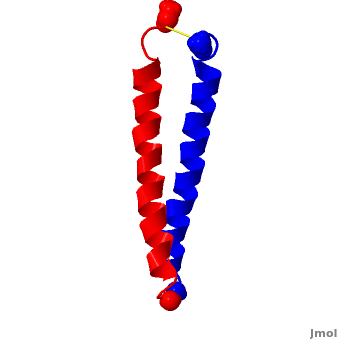C-Myc
From Proteopedia
| Line 1: | Line 1: | ||
| - | <applet load='2a93' size=' | + | <applet load='2a93' size='400' frame='true' align='right' scene name='C-Myc/Custom/1' caption='c-Myc is a [http://en.wikipedia.org/wiki/DNA-binding_protein DNA binding protein]'/> |
Revision as of 17:27, 16 July 2009
|
Overview
The c-Myc oncogene encodes a transcription factor, c-Myc protein, which is involved in the regulation of the cell cycle. C-Myc belongs to the Myc family of proteins including B-Myc, L-Myc, N-Myc, and s-Myc. c-Myc is a b-HLH-LZ (basic helix-loop-helix-leucine zipper) protein that must form a heterodimer with another b-HLH-LZ protein, Max, in order to bind DNA and activate transcription. Mutations in myc proteins or overexpression of their encoding genes have been linked to several forms of cancer, among these are lymphoma, myeloma, liver, lung, and breast cancer.
References
Dang, C.V.(1999) c-Myc Target Genes Involved in Cell Growth, Apoptosis, and Metabolism. Molecular and Cellular Biology, 19: 1-11.
Nair & Burley (2003) X-Ray Structures of Myc-Max and Mad-Max Recognizing DNA: Molecular Bases of Regulation by Proto-Oncogenic Transcription Factors. Cell, 112:193-205.
Ohtsuki, Nishitani, Hatamochi, Yawata, & Namba (1991) Analysis of methylation in the c-Myc gene in five human myeloma cell lines. British Journal of Haematology. 77: 172-179.
Takahashi et al., (2007) Induction of Pluripotent Stem Cells from Adult Human Fibroblasts by Defined Factors. Cell. 131: 1-12.
Kaji, Norrby, Paca, Mileikovsky, Mohseni, & Woltjen (2009) Virus-free induction of pluripotency and subsequent excision of reprogramming factors. Nature. 458: 771-776.
Proteopedia Page Contributors and Editors (what is this?)
Michal Harel, Hillary Sigale, Kim Smith, David Canner, Joel L. Sussman, Alexander Berchansky

